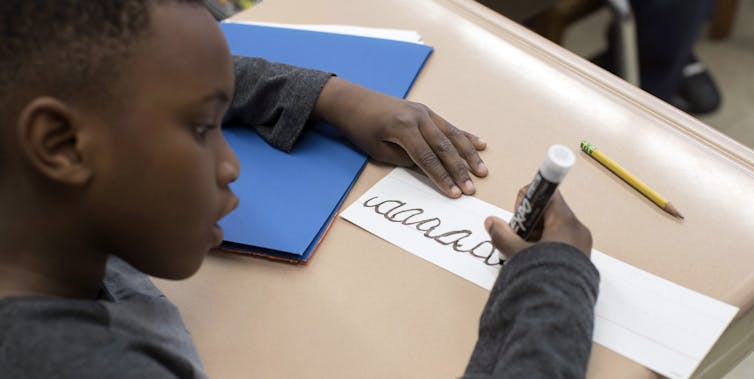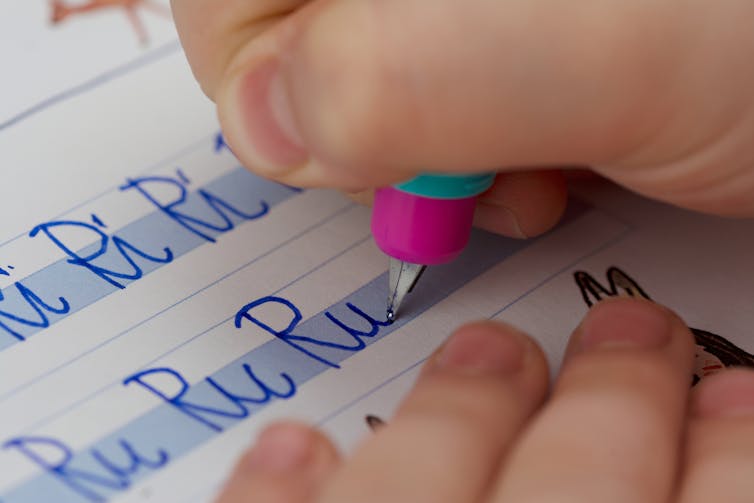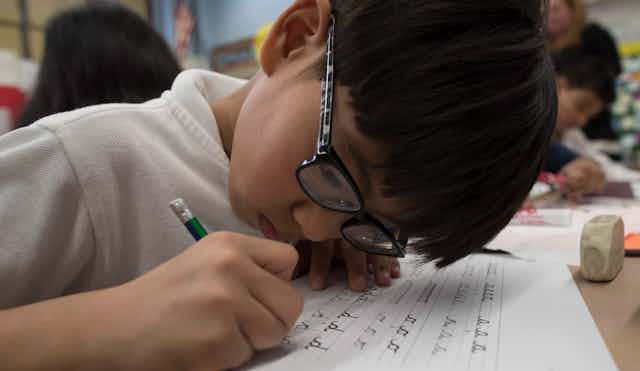For many, the return of mandatory cursive handwriting instruction in the Ontario curriculum, starting in Grade 3, is a welcome and long-overdue move on the part of the Ministry of Education. It is a re-emphasis on direct instruction in foundational skills.
Handwriting is a learned skill and it must be taught through direct, explicit, programmatic, developmentally progressive, consistent and sustained instruction — it will not simply be “caught” incidentally.
It is also not an end in and of itself, but a means to an end. It is not about presentation effects and looking pretty on the page. Rather, it is a powerful tool that affords a child a growing sense of confidence, pride and agency that their thoughts matter.
Here are some considerations about the significance of this announcement, and what will be needed to effectively implement the curricular shift.

How one writes connected to what one can say
Steve Graham, an expert in how writing can be used to support reading and learning, has spent decades of his scholarly life studying children’s handwriting. He finds that a legible, fluent/fast script contributes significantly to the quality of text generated.
My own research findings accord with those reported by Graham: in a study of writing by 245 Grade 4 students, fewer then 50 per cent of those students’ handwriting was under sufficient control to express their ideas on paper. Research suggests this can impede their academic success as the demands for written literacy accelerate over time, beginning in Grade 4.
For young learners, handwriting is a complex, demanding skill that involves integrating and mobilizing a host of neuromotor, visuospatial and cognitive skills, all in working memory.

Research in neuro and cognitive sciences
The resurgence of handwriting comes with evolving research in the neuro and cognitive sciences that underscore its importance in its connection to learning to read and as a cognitive tool. Researchers Daniel J. Plebanek and Karin H. James, experts in psychology and brain sciences, use functional magnetic resonance imaging to study brain activity. They report enhanced ability to recognize symbols when they are handwritten.
Note-taking by hand improves students’ ability to remember and retrieve information — and gives them a processing advantage. Handwriting lays down the neurocircuitry to the brain to make meaning, store and retrieve information.
Teaching handwriting has been marginalized
Teaching handwriting has long been marginalized in school curriculum, often trivialized as just an outdated skill.
Handwriting became crowded out by keyboarding and digital literacies associated with “21st century” learning goals and the shift to teaching “whole-language pedagogy” that emphasized context and meaning making, often at the expense of the underlying skills required to do so. Yet research reports young students write faster and produce better quality text when written by hand in comparison to using a keyboard.
It’s no surprise, then, that in a study from the United States, few teachers report feeling prepared to teach handwriting. My own research with Grade 2 teachers found many were unaware of how important direct and sustained instruction is for children’s learning trajectories.
In response to the ministry’s announcement about adding cursive instruction, a spokesperson for Elementary Teachers’ Federation of Ontario said the rollout was rushed and “the province’s expectation that educators will be ready to teach the overhauled language curriculum beginning this September is absurd.”
The success of introducing cursive back onto the Ontario curriculum is dependent on a number of key considerations.
1) What script style will be taught?
Various cursive scripts are available. Graham suggests a clean, uncluttered, utilitarian/functional script which he describes as mixed mostly manuscript.
With some cursive styles, like the Alku style, an economy of effort and ease of execution is afforded by the continuous stroke and the connections between the letters (known as ligatures). These features make the Alku style less demanding on the musculature of little hands and on the shift from visual to motor memory.
Fewer lift-offs from the page, together with making connections, support fluency of hand. Making twists, turns and loops is onerous for young learners.

2) Professional development of kindergarten to Grade 3 teachers.
Many early childhood education practitioners lack the insights, pedagogical knowledge and skill to teach early literacy skills to young learners. Initial teacher preparation programs at colleges and universities may not place sufficient emphasis on teaching early literacy skills, leaving these to the professional development needs of teachers.
3) Teachers need good learning resources.
Sample scripts for both lower and upper case, and manuscript to cursive hand will be necessary. Tracing sheets that reinforce direction and stroke sequence, copying exercises and illustrative exemplars of progress that show students what to look for will also be helpful for teachers. Script strips to tape onto each student’s desk and a wall chart will be helpful as permanent external memory supports.
4) Interventions in the preschool years.
The foundations of cursive handwriting are optimally learned in early childhood, with emergent writing that reflects their understanding of print as symbolic markings, and the beginnings of movement for drawing shapes. These understandings and skills are highly predictive of later success in written literacy development.
5) Making the time!
For teachers, it does not take a lot of time — 20 minutes of direct instruction daily, plus 40 minutes of extension and practice activities. This could involve a variety of printing and handwriting activities that are meaningful and purposeful for students. It could look like making cards and posters, partner and group activities that work on fine motor skills (like how many gummy bears can you pick up with a pair of chopsticks). Children need to automatize and create the muscle memory of how a letter is traced, and the direction and path of strokes. With worksheets, children can be asked to circle their best letter.
While cursive has been undervalued and misunderstood for many years, there is a compelling case for cursive handwriting on the curriculum.
Can we get it right this time?

